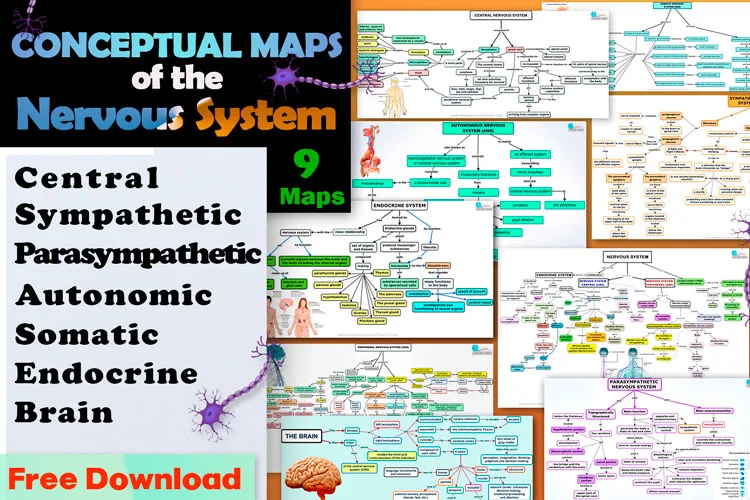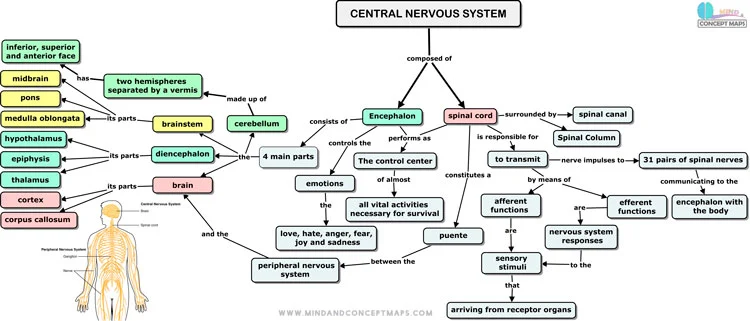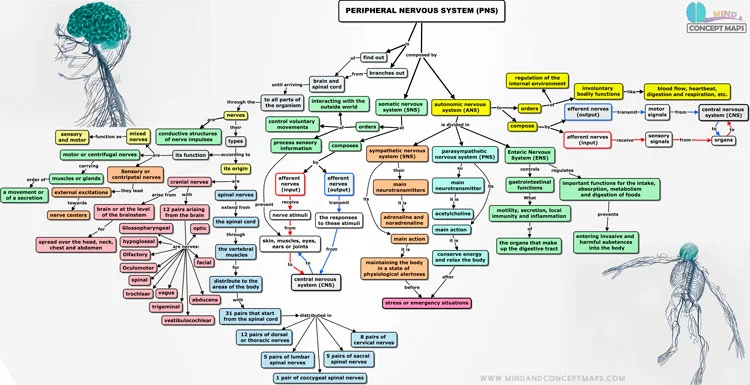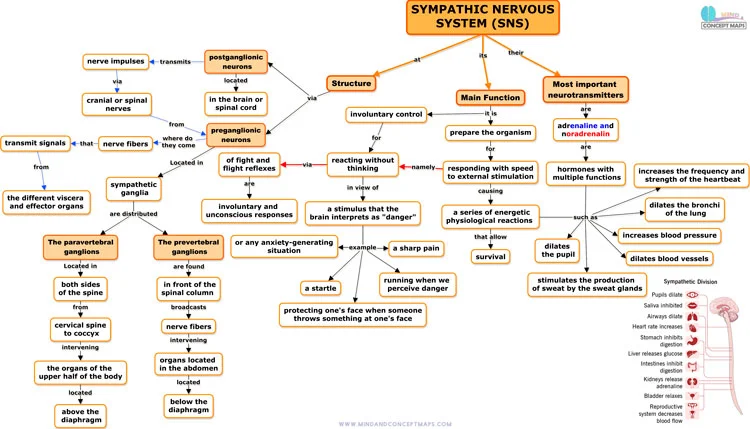In this post you will learn how to create a concept map of nervous system in an easy and practical way, you have several examples that can serve as a guide for you to develop your own semantic networks.
Each of the examples of concept maps of all parts of the nervous system can help you in your classes or university studies, you have high resolution images of each of them for free download.
- What is a concept map of the nervous system?
- How to make a concept map of the nervous system? With examples
- Conceptual map of the human nervous system, with all its parts and functions
- Conceptual map of the central nervous system
- Conceptual map of the peripheral nervous system
- Somatic nervous system concept map
- Conceptual map of the autonomic nervous system
- Sympathetic nervous system concept map
- Conceptual map of the parasympathetic nervous system
- Conceptual map of the endocrine system
- Concept map of the brain and its functions
Do you want to know with which software we made the concept maps? Click here and learn how to create concept maps with CmapTools, we explain how to use it and download it for free.
What is a concept map of the nervous system?
It is a graphic way to better understand and develop a complex subject, such as the nervous system of the human body.
A concept map will help you relate concepts and better understand how it is structured, how it works, its relationship with other systems and organs, among many other things.
You will be able to see in a single set and in a summarized form, all the information related to the nervous system, much more pleasant than seeing and reading large paragraphs in an anatomy book.
How to make a concept map of the nervous system? With examples
If you do not know how to create your concept map of the nervous system, I will give you some tips that will help you to start doing it. Although it may seem complex, it is actually easier than you think.
First step: Hierarchize the most important concepts
To start, look for information in a book or on the internet about the nervous system, read carefully to identify the most important concepts such as: parts, functions, location, etc.
Second step: identify the secondary concepts
The main parts of the nervous system, such as the peripheral system, are also structured in several sub parts. Here we can say that the secondary concepts are located. See the example image.
Third step: disaggregating specific concepts
Finally, place each of the specific concepts that you consider will give meaning to all the information. Here we relate concepts and establish those connections that will help us to better understand the concept map.
See how our map finally looks like!
Concept map showing the structures of the nervous system
The nervous system controls the functioning of all the cells of the human body, internal organs and extremities, maintaining constant communication with the external environment to generate a response to its stimuli, causing changes in muscles or glands.
The nervous system is composed of several other subsystems, so it is recommended to make a concept map of each of them to develop the topic more efficiently. We did it! Check them out below.
👉 Download also: Nervous system concept map pdf
Conceptual map of the central nervous system
It represents the command center where the main organs are located such as: the brain and the spinal cord, which are the structures that allow the control of the processing of all the functions of the body.
The following diagram describes all its parts, the tasks they perform and their relationship with other organs.
Peripheral nervous system concept map
It is called peripheral because it extends outside the central nervous system and is formed by the nerves and nerve ganglia that connect the central nervous system from the spinal cord to all parts of the body and connect with other subsystems outside the central system.
Somatic nervous system concept map
Also known as the voluntary nervous system, it is one of the two divisions of the peripheral nervous system.
It is responsible for controlling mainly voluntary muscle movements and reflex arcs. In other words, it is in charge of all the conscious functions we perform.
For example, moving our hands and legs, lifting our coffee cup and drinking while reading this article, etc.
Download the following concept map of the somatic system with a description of all its parts and its main functions.
Conceptual map of the autonomic nervous system
Known as the neurovegetative nervous system or visceral nervous system, it is divided into the sympathetic and parasympathetic nervous system.
It is in charge of regulating and controlling involuntary functions, such as digestion, heart rate, respiratory rate, breathing, metabolism, among others.
Sympathetic nervous system concept map
It is in charge of activating the organism's response to dangerous situations, these responses are for example: to run away, to defend oneself, to flee or to fight. These are actions that we do almost without thinking, involuntarily and immediately.
Conceptual map of the parasympathetic nervous system
The parasympathetic system likewise controls involuntary functions and actions, but in an antagonistic way to the sympathetic system.
It is in charge of conserving the energy of the organism after a fight or flight response, it leads us to a state of calm after a state of excitement.
In the following example of conceptual map each of its functions and how it is structured is detailed.
Conceptual map of the endocrine system
It is a system of the human body that works in collaboration with the nervous system, they keep in constant interaction and communication to control and regulate the functions in the organism.
The difference lies in the fact that the nervous system uses neurotransmitters to carry out its actions quickly, and the endocrine system uses hormones with a slower response speed.
You have a nice concept map of the endocrine system, which will give you many ideas on how to start elaborating a well-done concept map.
Concept map of the brain and its functions
When we say encephalon, the brain is included and when we say cerebrum the encephalon is also included. That is to say, they are one and the same set, only the brain is the largest and best known part of the encephalon.
A creative conceptual map of the brain with a nice design, besides containing the description of its hemispheres and lobes that compose it and the function of each one.
Concept maps are a wonderful tool that allow us to give a graphic and striking sense to any information, as in this case, the human nervous system.
They provide us with an effective way to identify the fundamental ideas and relationships between concepts of different levels of complexity.
We hope we have shown you how to make your concept map of the human body systems, which is such a complex yet fascinating topic.











